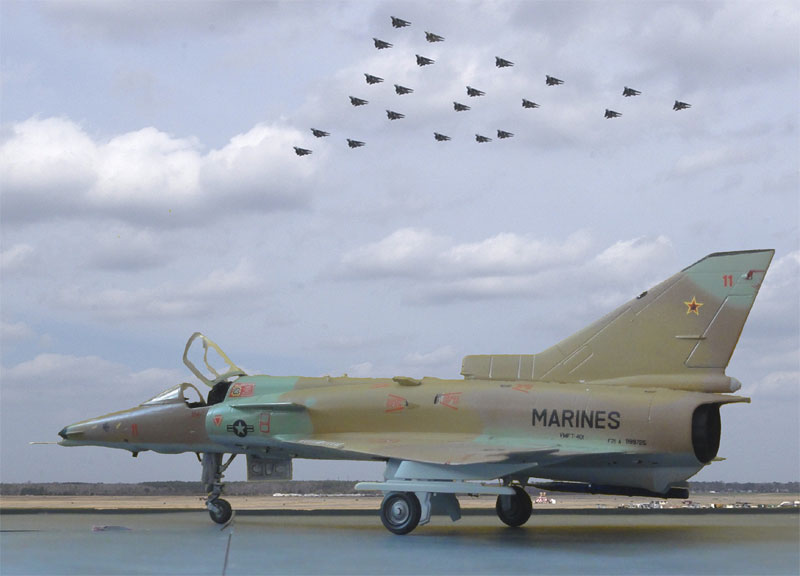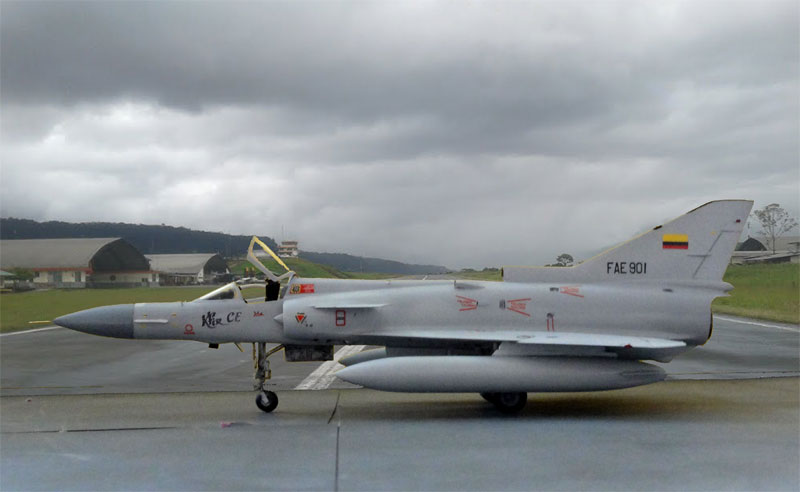[ Page 3 ]
... continued from Kfir page 2....
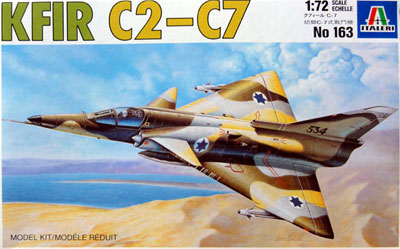
Italeri is another brand that
issued kits of the Kfir, here the box is seen for the Kfir C2 / C7 kit
#163. The kit looks a bit better than the older Hasegawa kits in 1/72 scale.
This kit was released about 1994. (it also appeared in a Tamiya box). Some
small differences look also to be there in the lower nose fairing as for
the C.7 which looks correct.
The kit has about 40 parts in light
grey-blue'ish soft plastic. The few panel lines are recessed so that is
better than raised. The instructions and main parts are seen below. The
Sidewinders are rather crude and far too short but pylons are provided
as well as a central fuel tank.
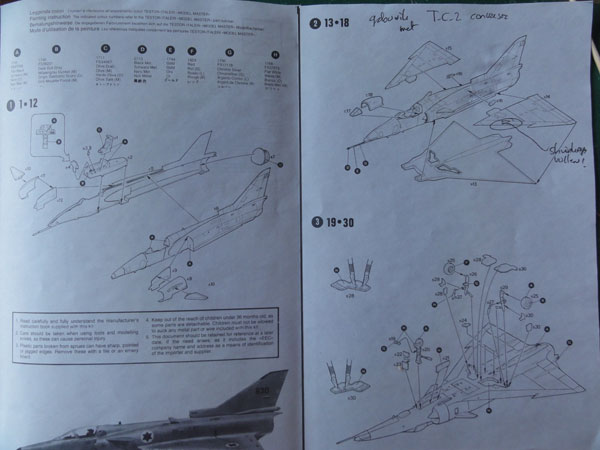 .
.
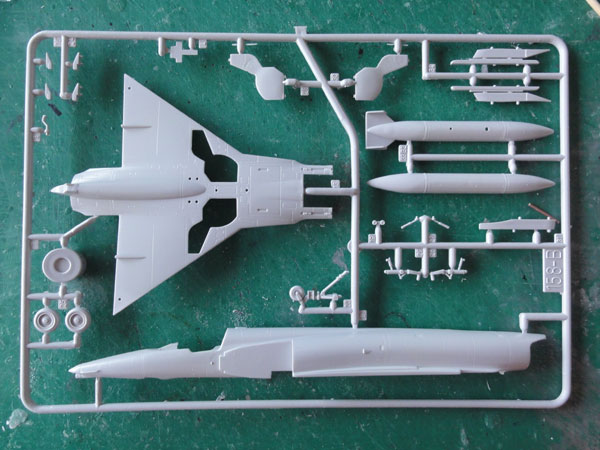 .
.
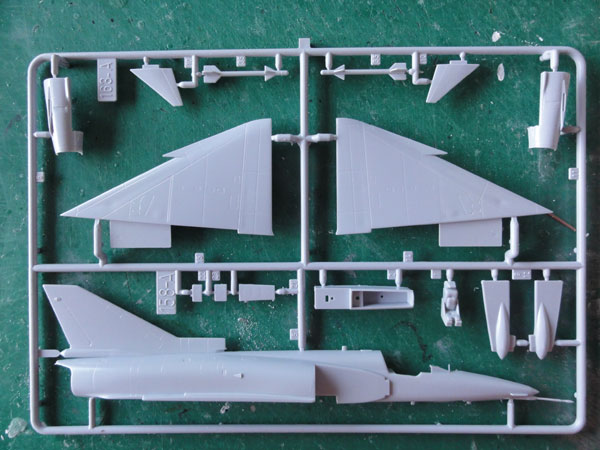
On the sprues it is indicated that
it has 2 sections: for kit #163 and kit #158. Here it is seen that kit
#163 has the larger canards to be fitted on the intake sides.
The cockpit is very simple and detailling is recommended. The jet exhaust is "undeep" and seems a bit too long, but that depends on how it fits inside and there are no internal details.
The landing gear is basic with no separate nose wheel but most doors are moulded closed. The wheel bays sidewalls are not closed. The pitot tube is moulded on the fuselage and breaks off easily. Better replace it.
As usual with Italeri decals, applying these need persuation to avoid "silvering", spoiling their appearance.
I had a couple of Italeri kits,
all to be made and used for conversions.

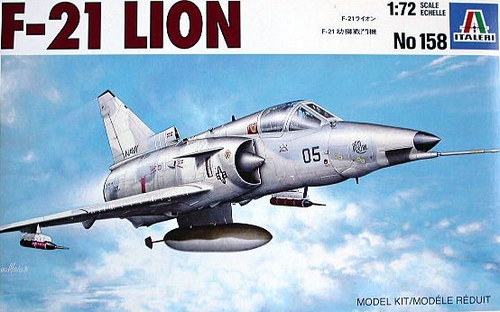
Italeri issued also a Kfir kit # 158 as the F-21 "Lion", this designation being used by the USA as the early Kfir type was used by US MARINES Agressor training squadrons. The kit was released around 1987 and decals in this kit are for one US Navy VF-43 agressor squadron.
This Kfir F-21 kit has the small canards in triangular shape and this is correct as it is a Kfir C.1 "plus" in fact. But still there are about 40 parts in light grey soft plastic and the panellines are recessed.
The kit at first sight looks very similar to their Kfir C2 kit but I found that some parts are different. The small canards are in this kit though still having the same part numbers, see the sprues above...
Some underwing stores are in the kit: a central tank, 2 pylons and even 2 ACMI pods (although I am not sure these are were used).
The wing has correctly not the outboard leading edge extensions which is correct for this early F-21A. But Italeri FORGOT the leading edge slots, so these added with a razorsaw and putty and sanding this slot smooth.
On to assembly.....
[ 4 ]
F-21 US
MARINES CORPS AGRESSOR
With these Italeri kits, some filler/putty
and sanding is needed at a lot of joints such as the wing-fuselage junction.
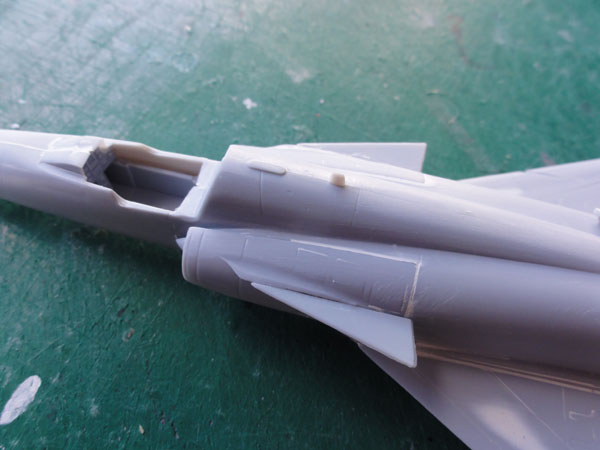
The smaller canards of the F-21 are
well seen here. The trailing edge flaps edges, ailerons edges and rudder
were cut in with a razor saw, this looks much better on any model. The
outher ailerons were set at a small angle.
Note that there are sink marks at the upper surfaces like in the wings. This is awkward and needs filling and sanding, note also the added leading edge slot and the straight leading edge as on early Kfirs including the F-21A.
The wheel bays got some detail from
scrap en the "walls" filled with card and white glue. On the fuselage spine
aft of the cockpit a flat antenna fairing is present as well.
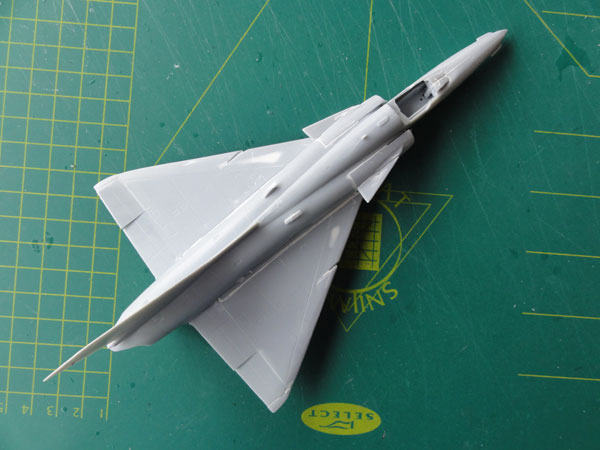
The trailing edge flaps edges, ailerons
edges and rudder were cut in with a razor saw, and the inner flaps drooped
a bit. After getting a base grey coat, the model was ready for the
"Agressors training" camouflage F-21 colour scheme.
Acrylic colours used for this F-21A
of the US MARINES Agressors were (starting airbrushing first the lighter
colours):
- lower surfaces grey FS 35622 using
Gunze Sangyo 314 ;
- light brown Sand FS 33717 using Revell
Aqua 88 ;
- green FS 34424* using Gunze Sangyo
50 ;
- tan brown FS 30219 using Gunze Sangyo
310 ;
*NOTE: later on I found out that on the IAF Kfir the Green is not FS34227 as seen of F-4's and F-16's but FS34424 for which RAF colour Sky Type "S" is an approximation. The green is probably also used on the US aircraft.
Decalling was next after the model
was ensured to have a gloss
undercoat.
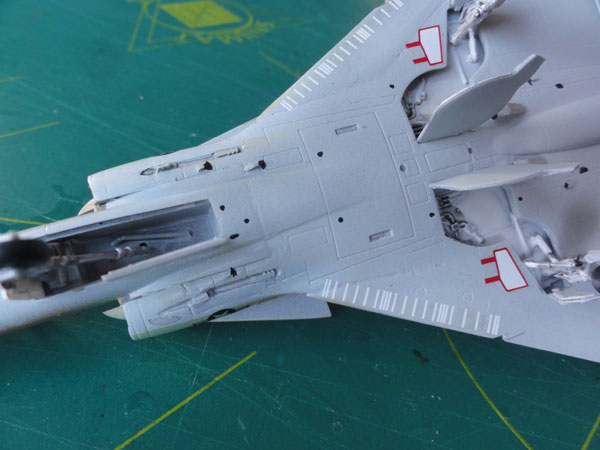
Most F-21 decals came from the AZTEC
set 72-054. It took quite some time particularly the very thin red
walkway lines.

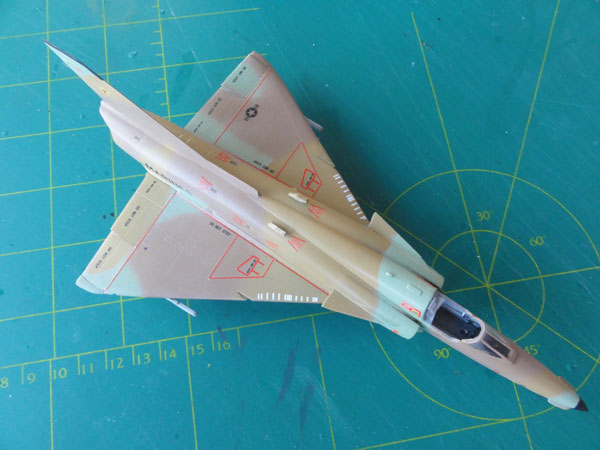
After decalling the model was finished with the landing gear added and so on.
Below the starboard outher pylon I added a dark blue painted ACMI pod that is in the Italeri kit.
The model got a semi-gloss coat to get an even sheen and to protect the decals for years to come.
The canopy was installed after it got some mirrors from scrap and metal pitot tube made from a needle added as well as smaller probes. That completed the "agressor" model.
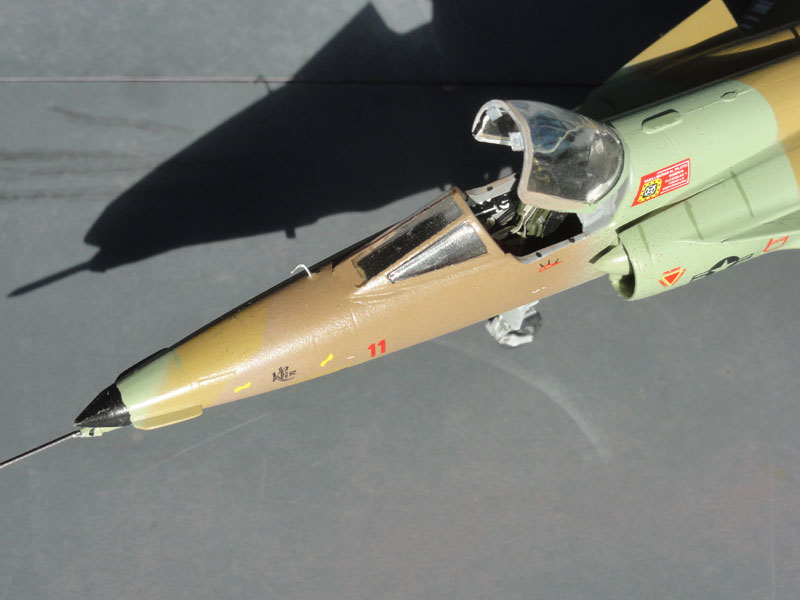
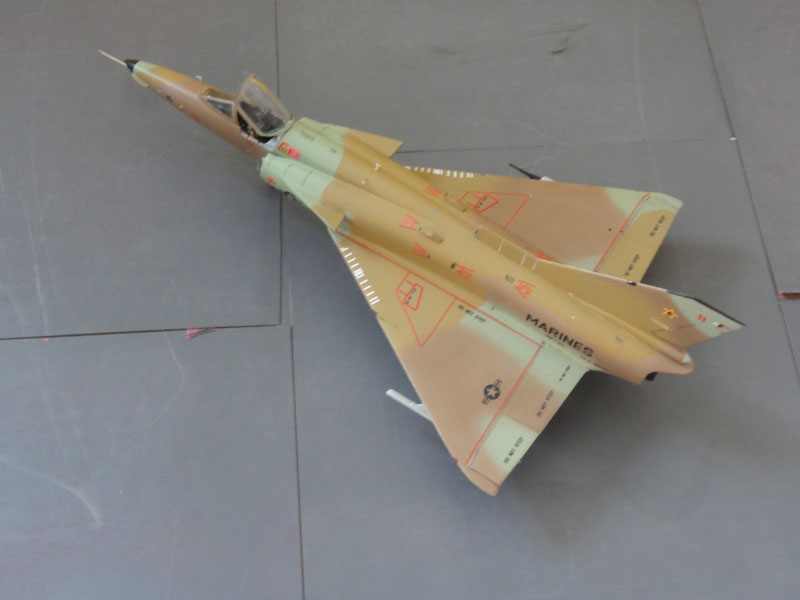
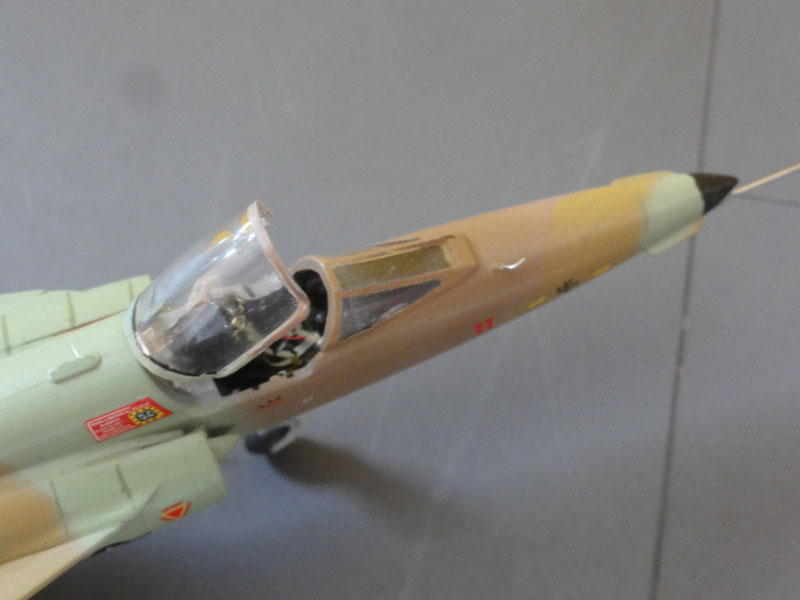
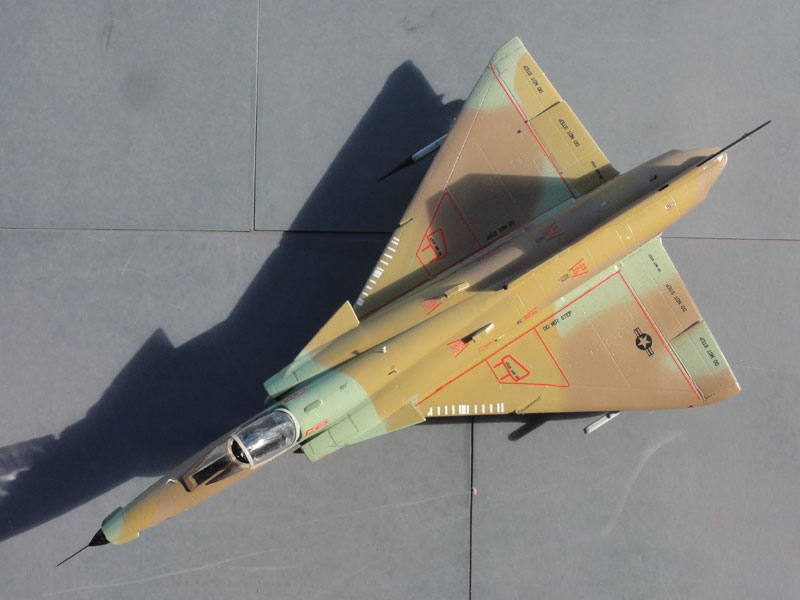

[ 5 ]
Kfir CE of Ecuador (FAE)
Another Hasegawa kit was made to represent a Kfir CE of Ecuador. It needed changes like the longer nose of the Ecuador Kfir CE and this Kfir looks to be a C.2 with a nose modification and with the larger canards. It also has a refuellling probe. I had a nice decal set from AZTEC 72-054.
The model was assembled as the previous Hasegawa kits as described on page 1. But the CE had a different long nose. So the nose of the kit was cut off the fuselage and from an old fuel tank from the spares box a longer nose was crafted on the kit. The new nose is 38 mm long and has a diameter of 16 mm in scale and the AZTEC decal drawing helps here as well to find one of a correct shape.
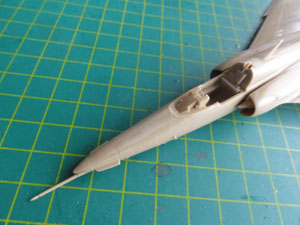 .
. .
.
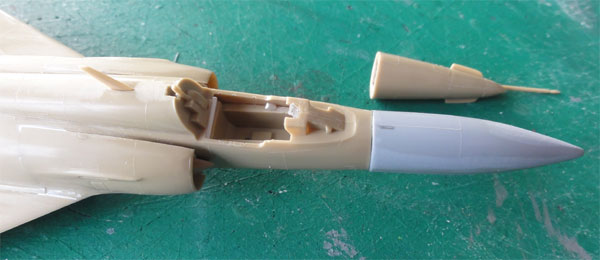 .
.
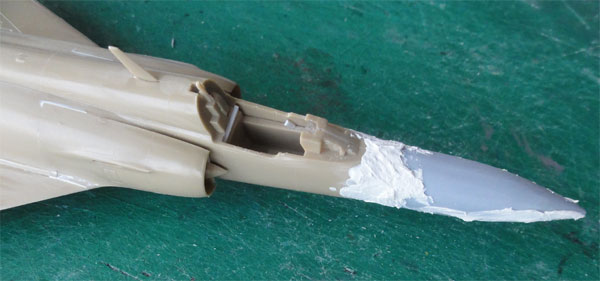
It needed some filler and sanding
but is not that difficult to do.
The model also got two large underwing
tanks. These tanks were retrieved from a 1/72
Heller Mirage III/V
kit but the fins were adapted and made from card. The large pylons were
also made from thick card sanded in shape. The tanks were installed so
painting would be in one go..
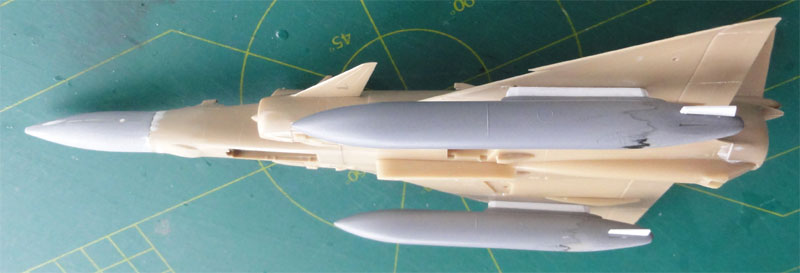 .
.
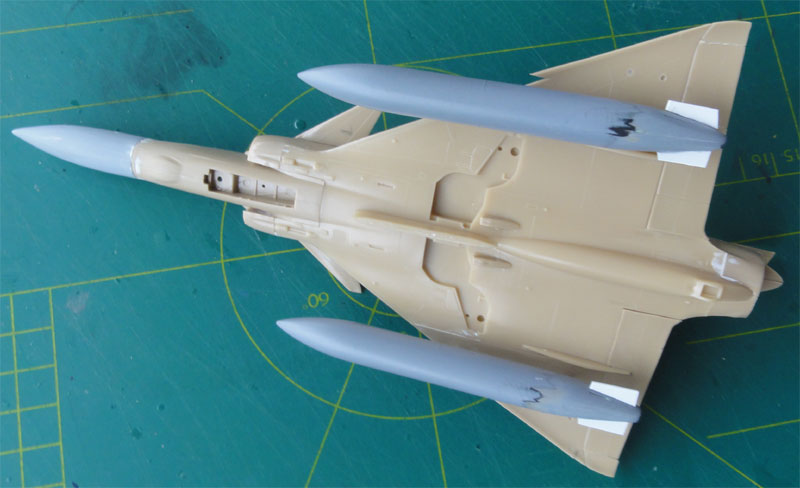 .
.
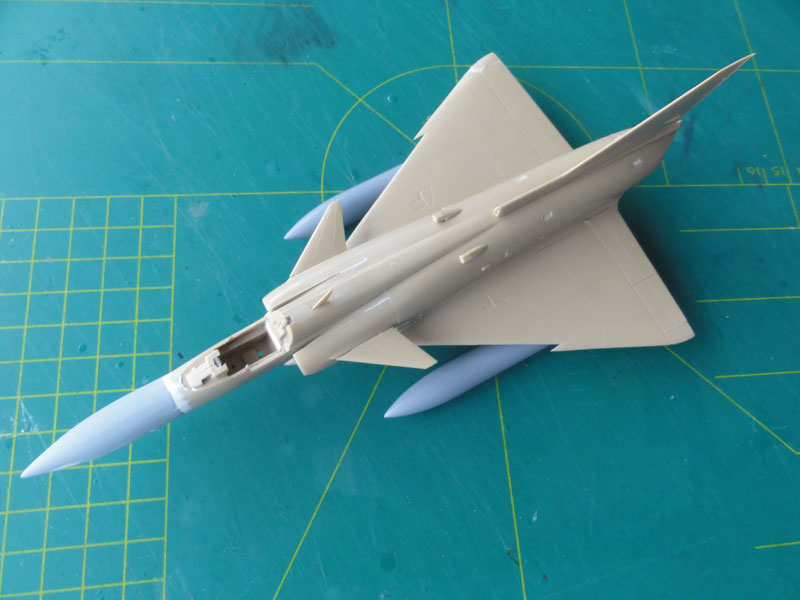
The rest of the model was unchanged. After some filling sanding the model got a base grey coat first. Next, the colours could be applied.
The colour scheme of the Kfir CE of
the FAE was :
- overall grey base FS 36628 using
Gunze Sangyo Mr Hobby 338 acrylic;
- grey spots FS26493 using Gunze Sangyo
338 with a bit darker grey mixed in.
- darker grey like nose radardome FS
36314 using Gunze Sangyo 307;
These acrylic colours were airbrushed. When done, the model got as usual to prevent "decal silvering" using the usual technique with Johnson Future, thinned with 40% Alkohol.
After decalling with the AZTEC 72-054 decals, the rest was completed. Undercarriage legs were painted off white and fitted.
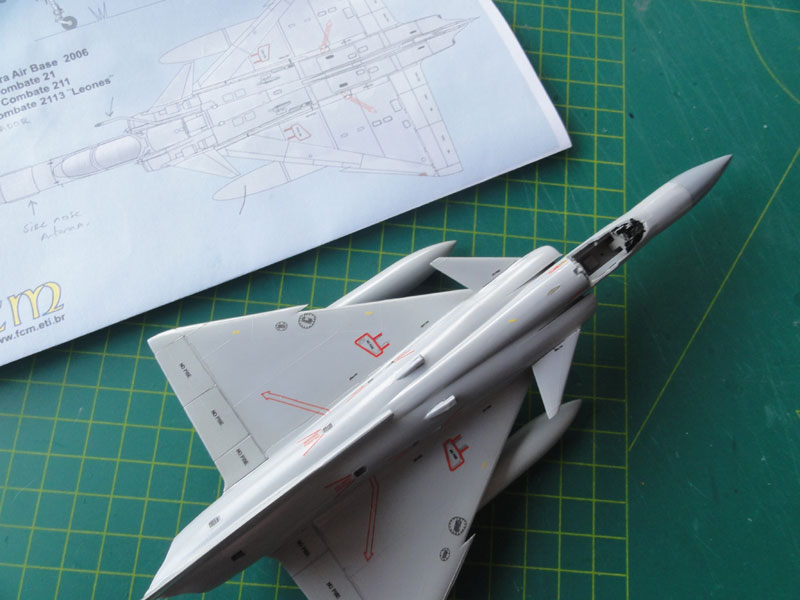
Note that no walkways are seen but
"No Pise" No Step markings. But the hot air exhaust warning arrows are
seen. This particular Kfir has also a leading edge tooth and this is in
the kit.
The gear legs were painted aluminium
and wheel bays "off white".
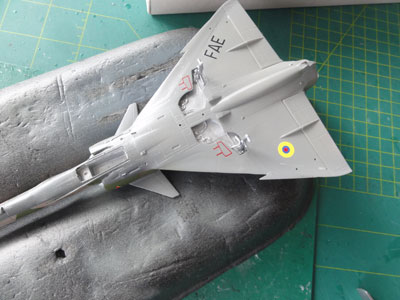
In addition, small strake antennas
(of the SIRE system) were added as well as some raised panels on the lower
nose sides. The large refuelling tank boom was made from plastic rod using
drawings and photos to get it's shape correct.

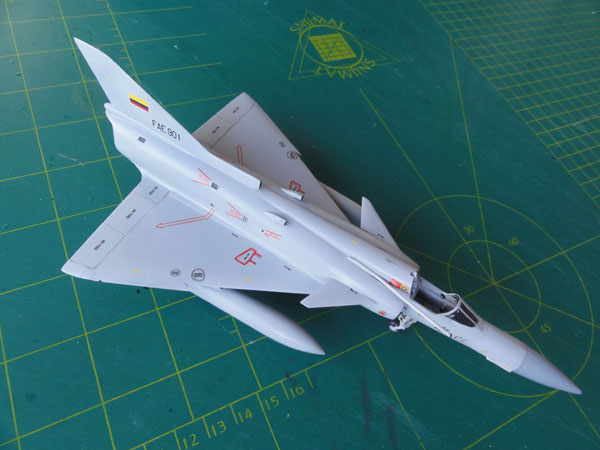
The model got a semi-gloss coat to get an even sheen and protect the decals.
On the nose the pitot tube made from
a metal needle was fitted. Smaller pitots were added and mirrors inside
the canopy. The canopy was set in place and hat completed the Kfir CE model.
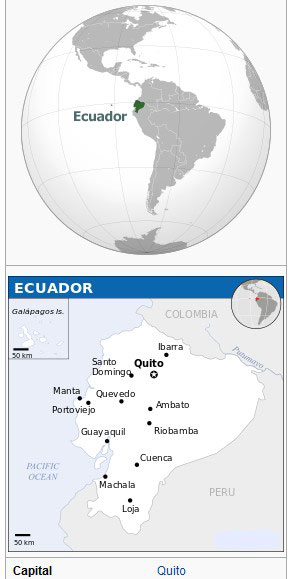 .
. ..
..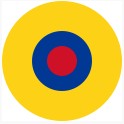 ...............
...............
[area: 283,561 sq.km | population: 18 million | capital: Quito | GDP 6,500 USD nominal per capita ]
In Ecuador military aviation started in 1910 after a conflict with Peru. In 1941 it lost a lot of territory to Peru and it was decided to establish more armed forces. The Air Force was established much later in the Second World War starting with the flying school with Ryan PT-22, PT-19, CW.22 aircraft and Harvards from 1942. After the war the air force "Fuerza Aerea Ecuatoriana" the first jets arrived in 1955 with some 12 Gloster Meteor FR.mk.9. These were followed by types like F-80 fighters and 8 T-33 from end 1956 and some 9 AT-33. A new airbase Taura was created near Guayaquil and types that followed were BAC Strikemaster from 1972 and A-37 attack aircraft. A spectacular purchase were SEPECAT Jaguars from 1977 with some 10 Jaguar ES and 2 EB trainers. Also from France from 1979 no less than 18 Mirage F-1 fighters were acquired. In 1981 and 1985 conflicts were in the Cenepa region with Peru involving fighter aircraft. The FAE obtained (after US President Regan gave permission to use the American licensed J79 engine) from Israel some 10 Kfir C.2 and 2 re-furbished former IAF TC.2 trainers. Some 19 additional AT-33 from the USA and 6 Strikemasters from the U.K were acquired from 1987. Later from 1996 more Kfirs followed: 3 C.2, 1 TC.2 and 2 CE Kfirs. Main bases are Quito Mariscal Sucre, Lago Agrio, Eloy Alfaro on the coast and Ulpiano Paez at Salinas and Taura and Simon Bolivar near Guayaquil.
From 2003 most Jaguars were put in reserve and in 2007 2 ex-Botswana Strikemaster mk.83 aircraft were added to the close ground support fleet.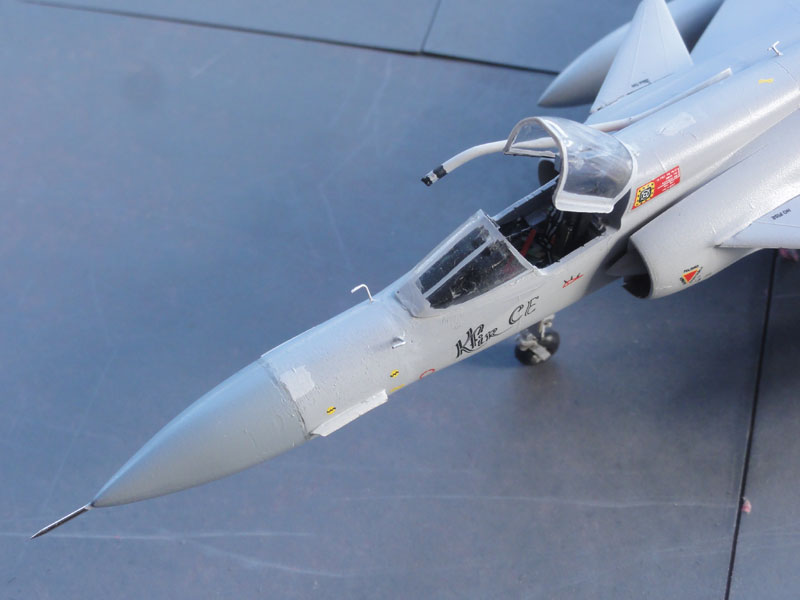
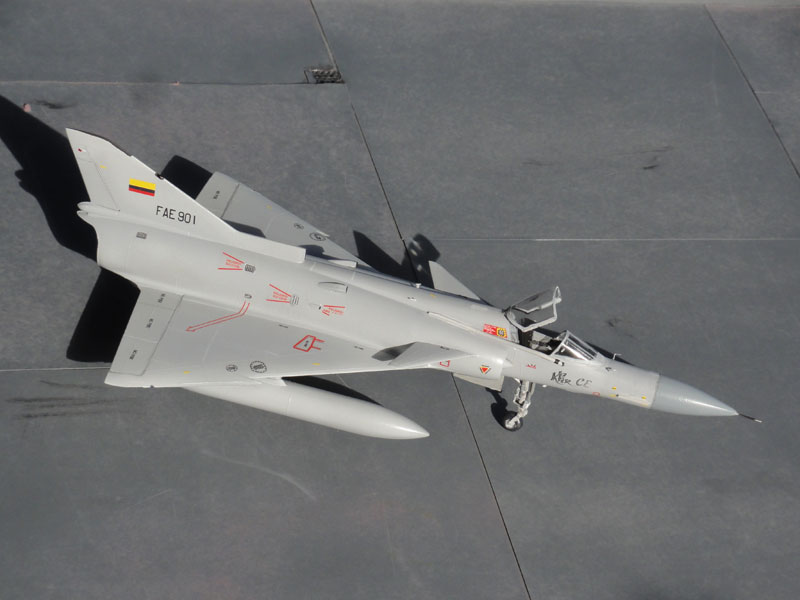
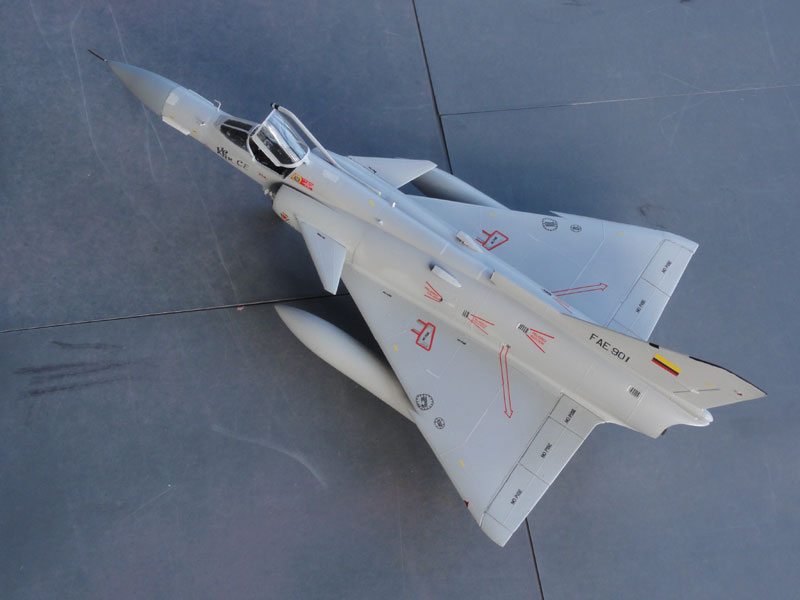

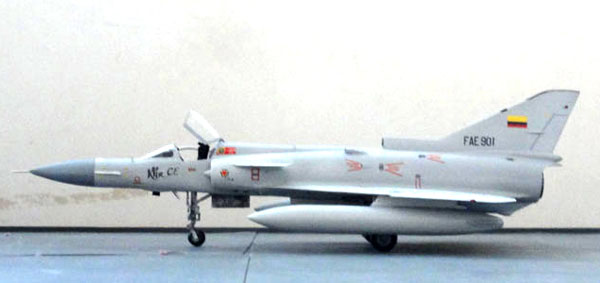 .
.
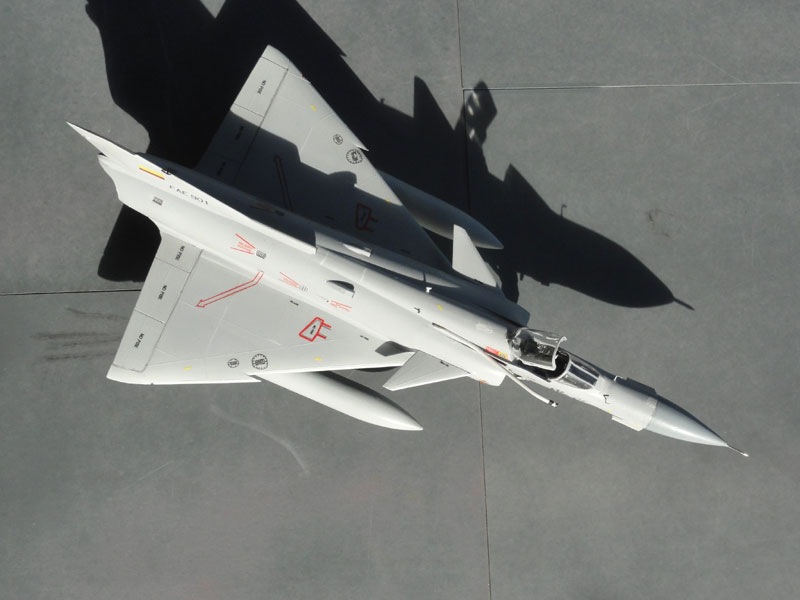
On to next [ Page 4...]


(c) Copyright Meindert "designer"/ All rights reserved. Your comments are welcomed by webmaster
Created this page
April 13, 2016

